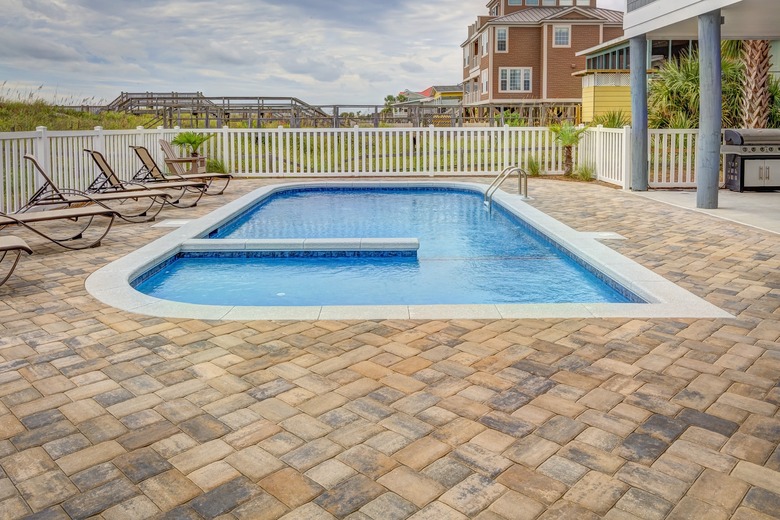How To Raise The Chlorine Level In A Swimming Pool
When you raise the chlorine level in a pool, you're actually raising the free available chlorine (FAC) concentration. The pool may already have plenty of chlorine–you may even be able to smell it–but the chlorine may have formed compounds with contaminants, rendering it unavailable for sanitizing. This is usually the case when the chlorine odor is noticeable. One way to raise the chlorine level is to use chemicals to free the chlorine from these compounds and turn it back into FAC. The other way is simply to add more chlorine in one of the five forms in which it is sold in stores.
How Chlorine Works as a Sanitizer
How Chlorine Works as a Sanitizer
You can buy chlorine as sodium, calcium or lithium hydroxide, as well as in the form of dichlor or trichlor tablets. Unlike hydroxide compounds, dichlor and trichlor tablets also contain cyanuric acid, which stabilizes the chlorine and prevents it from being degraded by sunlight. If testing reveals the pool water already has a cyanuric acid concentration between 25 and 50 parts per million, you don't need dichlor or trichlor tablets, and you shouldn't use them, because elevated cyanuric acid levels actually impair the ability of chlorine to kill certain pathogens.
All of these chemicals dissociate in water to form hydrochloric acid (HCl) and hypochlorous acid (HOCl), which is the sanitizing agent. Hypochlorous acid combines with bacteria and pathogens and kills them, but it also combines with nitrogen and ammonia compounds to form chloramines, which emit the familiar chlorine odor. Eventually, all the chlorine either becomes bound up as chloramines or evaporates. When testing reveals that the FAC concentration has fallen below 1 ppm, it's time to add more chlorine, shock the pool or do both. Ideally, the FAC concentration should be between 1 and 3 ppm.
Check the pH Before Adding Chlorine
Check the pH Before Adding Chlorine
Because HOCl is an acid, it doesn't last in alkaline water. In fact, the sanitizing power decreases rapidly with rising pH. Before adding chlorine, check the pH, and if it's higher than 7.8, add muriatic acid or sodium disulfate to bring it down to a value between 7.2 and 7.6. Chlorine sanitizes well in water with a pH below 7.2, but acidic water corrodes fixtures in the pool and causes discomfort for swimmers. So raise the pH with soda ash or baking soda if it's too low.
How to Raise the Chlorine Level
Step 1
Test the FAC concentration so you know how much you have to raise it. If the water is cloudy or green, you may have to shock the pool by raising the chlorine level to 10 ppm or more, and wait for the level to drop to 5.5 ppm before swimming. If the water is clear, just add enough to raise the concentration to a value between 1 and 3 ppm.
Step 2
Calculate the pool volume if you don't know it already. Measure the width and length of the pool and the average depth of the water in feet, and multiply these numbers together. Convert the result to gallons using the conversion 1 cubic foot = 7.5 gallons.
Step 3
Read the instructions on the product you are using to determine how much you need to add to raise the chlorine concentration to the desired level based on the volume of your pool.
Tip
If you use liquid bleach, which is a 5 to 6 percent sodium hydroxide solution, you need twice as much as you would if you use pool chlorine, which is a 12 percent solution.
Step 4
Backwash the pool filter, and vacuum any sediment on the bottom to Waste. This ensures that more of the chlorine you add will remain available in the pool water.
Step 5
Add the chlorine in the late afternoon or early evening to prevent it from being degraded by sunlight. This is especially important if the cyanuric acid concentration in the water is low. If the pool water has a cyanuric acid concentration of less than 25 ppm, consider adding chlorine in the form of dichlor or trichlor tablets.
Step 6
Pour the required amount of chemical into the sides of the pool gradually while you walk around the deck. Never pour it directly into the skimmer. Run the circulation pump for about eight hours after adding chlorine or pool shock.
